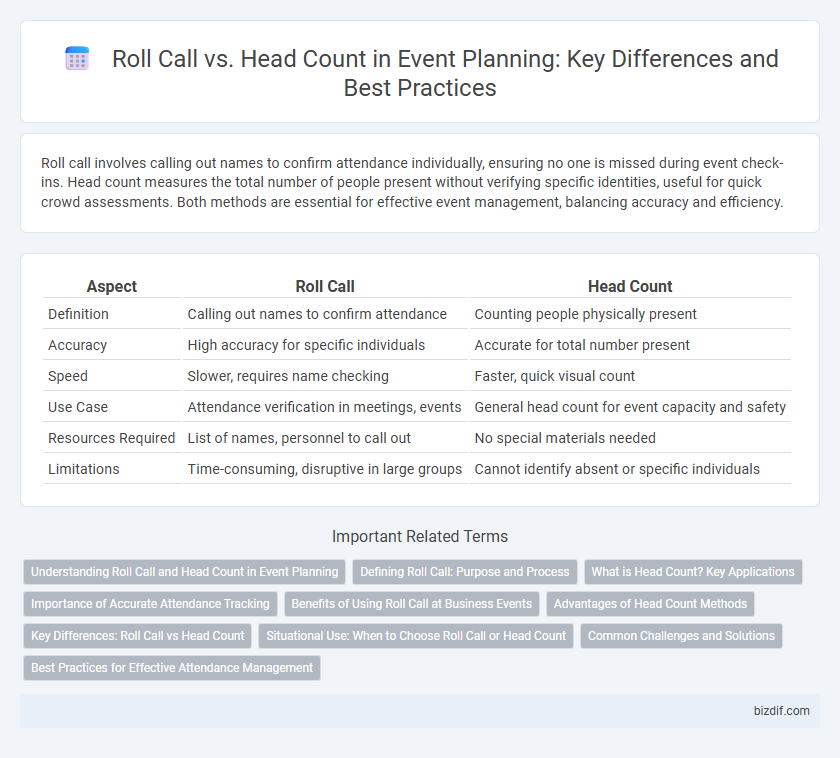Roll call involves calling out names to confirm attendance individually, ensuring no one is missed during event check-ins. Head count measures the total number of people present without verifying specific identities, useful for quick crowd assessments. Both methods are essential for effective event management, balancing accuracy and efficiency.
Table of Comparison
| Aspect | Roll Call | Head Count |
|---|---|---|
| Definition | Calling out names to confirm attendance | Counting people physically present |
| Accuracy | High accuracy for specific individuals | Accurate for total number present |
| Speed | Slower, requires name checking | Faster, quick visual count |
| Use Case | Attendance verification in meetings, events | General head count for event capacity and safety |
| Resources Required | List of names, personnel to call out | No special materials needed |
| Limitations | Time-consuming, disruptive in large groups | Cannot identify absent or specific individuals |
Understanding Roll Call and Head Count in Event Planning
Roll call in event planning involves calling out names to confirm the attendance of registered participants, ensuring all expected guests are present. Head count refers to the physical counting of individuals at the event to verify actual attendance numbers, often used for safety and capacity compliance. Understanding the distinction helps planners accurately track guest presence and manage event logistics effectively.
Defining Roll Call: Purpose and Process
Roll call serves as a systematic method to verify the presence of all registered participants at an event, ensuring accurate tracking and security. The process involves calling out names or assigned numbers from a predetermined list, prompting attendees to respond and confirm their attendance. This method helps event planners maintain order, manage resources effectively, and address no-shows promptly.
What is Head Count? Key Applications
Head count refers to the total number of individuals physically present at an event or location, crucial for accurately managing attendance and resource allocation. It plays a key role in event planning by ensuring safety compliance, optimizing catering quantities, and facilitating effective crowd control. Utilizing electronic tracking or manual tallying methods enhances precision in head count data, supporting smooth event operations and informed decision-making.
Importance of Accurate Attendance Tracking
Accurate attendance tracking during event planning hinges on distinguishing between roll call and head count, with roll call ensuring individual accountability through name verification, while head count provides an immediate total of attendees present. Reliable data from roll calls prevents discrepancies and strengthens emergency response measures, securing attendee safety and resource allocation efficiency. Precise attendance records also optimize event logistics, vendor coordination, and post-event analysis for future improvements.
Benefits of Using Roll Call at Business Events
Roll call at business events ensures accurate attendee verification by systematically confirming each participant's presence, minimizing errors common in traditional head counts. This method enhances security and accountability by providing a detailed record of attendance, which is essential for follow-up actions and compliance. Employing roll call improves event flow management and supports data-driven decision-making for future event planning.
Advantages of Head Count Methods
Head count methods in event planning offer precise attendee tracking by providing real-time data on the exact number of participants present, enhancing resource allocation and ensuring safety compliance. This method minimizes errors commonly found in roll call processes by eliminating reliance on manual name checks, thus speeding up the verification process. Utilizing digital head count technologies improves overall event efficiency and attendee management accuracy, making it a preferred choice for large-scale events.
Key Differences: Roll Call vs Head Count
Roll call involves verbally confirming attendance by calling out each participant's name, ensuring individual acknowledgment and accountability. Head count is a visual or manual tally of attendees, focusing on the total number present without individual identification. The key difference lies in roll call's emphasis on personal verification versus head count's emphasis on quantity verification.
Situational Use: When to Choose Roll Call or Head Count
Roll call is best used in formal events or meetings requiring confirmation of individual attendance, such as conferences or board meetings, ensuring accurate participant tracking. Head count suits dynamic or large-scale gatherings like festivals or trade shows, where a rapid estimation of attendees suffices for logistical and safety purposes. Selecting between roll call and head count depends on the event's scale, formality, and the precision needed for attendance verification.
Common Challenges and Solutions
Roll call often faces challenges such as inaccurate attendance tracking due to missed responses or delayed updates, leading to confusion in event coordination. Head count methods can struggle with real-time accuracy, especially in large or dynamic event settings, causing inefficient resource allocation. Employing digital check-in systems and mobile head count apps provides solutions by offering instant, reliable attendance data and reducing human error.
Best Practices for Effective Attendance Management
Roll call and head count are essential techniques in event planning for accurate attendance management, each offering distinct benefits: roll call directly verifies individual presence while head count provides a quick overall tally. Best practices include integrating digital check-in systems to streamline roll call, using wristbands or badges for easy head counting, and cross-verifying both methods to prevent discrepancies. Implementing real-time attendance tracking improves communication, enhances security, and optimizes resource allocation during events.
Roll call vs Head count Infographic

 bizdif.com
bizdif.com